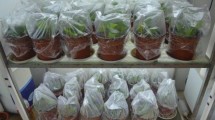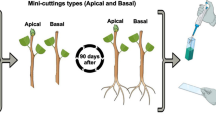Abstract
Picea crassifolia Kom, a perennial arbor species is recognized as one of the most adaptable plants found to date in Qilian Mountains. To explore the cutting reproduction technology of P. crassifolia and reveal its rooting mechanism, cuttings of P. crassifolia with different cutting types (softwood, hardwood and root), positions (top, upper, middle and bottom) and ages (7, 10, 15, 20, 25 year-old) were cultivated in a field experiment. One-year old softwood and hardwood cuttings were collected from 7-, 10-, 15-, 20-, and 25 year-old healthy ortets to analyze the changes from endogenous hormones and organic nutrients. Results indicate that the softwood cuttings (0.5–1.0 cm in diameter) from upper branches of 15 year-old ortets shows better growth performance by improving rooting indexes, including a significant increase in rooting rate and a decrease in basal rot rate. Concomitantly, increasing rooting quantity and root length also increased. It is noteworthy that the high rooting rate of P. crassifolia cuttings due to its ability to accumulate high concentrations of indole-3-acetic acid (IAA) and total carbon (TC) rather than abscisic acid (ABA) and total nitrogen (TN). The rooting rate was mainly regulated by the IAA/ABA and TC/TN ratio. In summary, our results suggest that the softwood cuttings (0.5–1.0 cm in diameter) from upper branches of 15 year-old P. crassifolia can be considered as an effective strategy to improve cutting rooting rate, and the IAA/ABA and TC/TN ratio was one of the main factors limiting the cutting rooting rate of P. crassifolia.


Similar content being viewed by others
References
An SP, Wang MQ, Shi H, Zhang SZ, Ma JW, Wang JH (2011) Screening of cutting root-inducing agent and cutting effect of Picea likiangensis. For Sci Technol 25(3):88–91
Bengt B (1981) Large scale propagation of Norway spruce (Picea abies (L). Karst.) by cuttings. Symposium on clone forestry. Uppsala, Sweden, 33–56
Bentzer BG (1988) Rooting and early shoot characteristics of Picea abies (L) Karst. Cutting originating from shoots with enforced vertical growth. Scand J For Res 3(1–4):481–491
Bhardwa JDR, Mlshra VK (1998) Rooting response of stem cuttings of maple to IBA and cutting position. Indian J For 21(1):16–18
Browne RC, Davidson CG, Steeves TA (1997) Effects of ortet age on adventitious rooting of Jack pine (Pinus banksiana) long-shoot cuttings. Can J For Res 27(1):91–96
Buhtz A, Kolasa A, Arlt K, Walz C, Kehr J (2004) Xylem sap protein composition is conserved among different plant species. Planta 219(4):610–618
Cai JX (2010) Effect of different containers on strengthen raising seedling of Qinghai Spruce. Qinghai For Sci Technol 4:55–56
Chen GH, Wang HQ, Zhang SG, Zhang JG, Wang JH (2007) Effect of pruning and growth regulators on the bud growth and development of Picea crassifolia seedlings. For Res 20(3):375–380
Clair JBS, Kleinschmit J, Svolba J (1985) Juvenility and serial vegetative propagation of Norway spruce clones (Picea abie Karsts). Silvae Genet 34(1):42–49
Dormling I, Kellerstram H (1981) Rooting and rejuvenation in propagating old Norway spruce by cuttings. Uppsala: Swedish University of Agricultural. Science 32:65–72
Du R, Jia CX (2012) Age effect of cutting propagation for two dwarf colorful conifers. J Northeast For Univ 40(3):24–27
Du GZ, Zhou FY (2007) The status review of conventional vegetative propagation of conifers. Protect For Sci Technol, supplement: 46–48
Duan RG (2012) Distribution of the Qinghai spruce forest on the southern slope of Qilian Mountains. J Qinghai Univ 30(3):74–79 (Natural Science Edition)
Duan CS, Zhang SG, Wang JH, Zhang SZ, Ma JW, Hu MH (2009) Rooting capability of twigs of three spruce species. J Northwest For Univ 24(6):59–61
Fang JL, Song Y, Cao Y (2013) The cutting reproduction technology of new superior conifers. Beijing Hortic 2:30–34
Gomes LJL, Arrue MV, Lopez G, Sterk D, Richard R, Gracia JM, Sabre AG, Frangi JP (2003) Wind erosion in a semiarid area of Spain: the WELSONS project. Catena 52(3):235–256
Guo SJ (1997) Progress of study on rooting anatomy and physiology of forest tree cuttings. J Beijing For Univ 19(4):64–69
Guo NL, Yang F, Li MX (2003) Study of changes of vegetation and snow area in Qilian Mountains using meteorology satellite data. J Appl Meteorol Sci 14(6):700–707
Guo SJ, Ling HQ, Li FL (2004) Physiological and biochemical basis of rooting of Pinus bungeana cutting. J Beijing For Univ 26(2):43–47
Hannerz M, Almqvist C, Ekberg I (1999) Rooting success of cutting from young Picea abies in transition to flowering competent phase. Scand J For Res 14(6):498–504
Hu MH, Zhang SZ, Ma JW, Jin JC (2008) Cutting propagation techniques of Picea abies (L)Karst. Shanxi For Sci Technol 4:20–24
Hu MH, Ouyang FQ, Jia ZR, Wang JH, Zhang SZ, Ma JW (2014) Factors affecting rooting of Picea abies shoot cuttings and individual selection with high rooting ability. Scienta Silvae Sinicae 50(2):42–49
Huang HQ, Huang Y (2011) Analysis of the cutting propagation of ornamental conifers. Grand Week 16:87
Huang GX, Mou GH, Wang YQ, Gao Y, Bo PT, Ma ZG (2011) Study on the cutting technology of Picea glauca. J Liaoning For Sci Technol 4:22–24
Ji HH, Yao YZ (2010) The container breeding technique of Qinghai Spruce. Anhui Agric Sci Bull 16(10):204–205
Ji KZ, Wang ZR, Wang MM, Chen TH (1996) Progress and countermeasures in conifer vegetative propagation. World For Res 9(4):17–22
Ji KS, Wang ZR, Chen TH, Wang MX (1998) A study on rooting ability variation of Masson Pine (Pine Massoniana Lamb) cuttings. J Nanjing For Univ 22(3):66–70
Jin JC, Hu MH, Zhang SZ, Ma JW, Zhang SG, Wang JH (2009) Rooting capability of twigs of Picea abies. J Northwest For Univ 24(5):70–73
Kang CZ, Liu SZ, Li DL, Wei LY, Zhu GQ, Zhu SJ (2010) Study on the seedling growth regularity of Picea mongolica in arid desert areas. J Anhui Agric Sci 38(25):13713–13716
Kleinschmit J, Schmidt J (1977) Experiences with Picea abies (L) cutting propagation in Germany and problems connected with large scale application. Silvae Genet 26(5–6):197–203
Lei J, Zhang HB, Fan JP (2012) Blooming and fruiting characteristics in clonal seed orchard of Picea crassifolia. J Northwest For Univ 27(6):70–74
Li HS (2003) The principle and technology of plant physiology and biochemistry experiment. China Higher Education Press, Beijing, pp 186–238
Liang J, Zhang I (1997) Collection of xylem sap at flow rate similar to in vivo transpiration flux. Plant Cell Physiol 38(12):1375–1381
Liu Q, Li J, Wang CY, Sun HB (2011) Study of hormone and substrate in the cutting propagation technology of Pieea koraiens. Modern Hortic 17:6–7
Liu L, Jiang YM, Zhang SZ, Ma JW, An SP, Wang JH (2012) Genetic variation and selection of half-sib families of Qinghai spruce at seedling stage. J Northeast For Univ 40(7):11–13
Ma CG (1993) State of development of clone forestry of Picea asperata in the world. World For Res 6:24–31
Meng HJ, Liu JQ, Liu XD, Zhao WJ (2011) Species composition and vertical distribution pattern of diversity of the Picea crassifolia community in Qilian Mountains of Gansu China. Ecol Environ Sci 20(3):435–440
Peng JZ, Chang ZQ, Feng Q (2008) Influence of temperature and soil moisture on soil respiration of Picea crassifolia in Qilian Mountains. J Arid Land Resour Environ 22(3):165–169
Shi JS, He ZX, Ye ZH, Li SM, Yu RZ, Weng YZ, Wu QZ (1993) Study on genetic variation of cutting rooting ability of Chinese fir clones. J Nanjing For Univ 17(4):9–14
Talbert CB, Ritchie GA, Gupta P (1993) Conifer vegetative propagation: an overview from a commercialization perspective. In: Ahuja M R, Libby W J. Clone forestry, genetics and biotechnology, Springer, Berlin Heidelberg 145–181
Wang QH (2008) Report on the cutting propagation of four Picea species. For Sci Technol 33(5):6–7
Wang XR, Che ZX (2012) The Spatial variation analysis on physical and chemical indicators of Picea crassifolia in Qilian Mountains. J Gansu For Sci Technol 37(1):6–12
Wang WF, Li Y, Ma YJ, Li LD (2009) Establishment and optimization of ISSR-PCR reaction system for Picea crassifolia Kom. Agric Sci Technol 10(3):68–71
Wang MQ, Shi H, Yang W, Zhang SZ, Ma JW, Wang LF, An SP (2011a) Contrast test on effect of cuttings condition on rooting of three species of Picea. J Gansu For Sci Technol 36(1):28–31
Wang MQ, Shi H, Yang W, Zhang SZ, Ma JW, Wang LF, An SP (2011b) The contrast test of cuttings effect on the cutting reproduction of three species of Picea. J Gansu For Sci Technol 36(1):28–31
Wu YS (2008) The dense transplanting reproduction technology of Qinghai spruce (Picea crassifolia). Modern Agric Sci Technol 19:87–88
Zhan YG, Yang CL, Jing ZF, Wang YC (2001) Endogenous hormones and nutritive material in softwood cuttings of Betula platyphylla during rooting. J Northeast For Univ 29(4):1–4
Zhang HG (1992) The asexual reproduction of European Spruce. Foreign For 22(4):8–10
Zhang XP, Fang YM, Huang SH (2004) The endogenous hormone’s variation during the adventitious roots formation of Hybrid Tuliptrees by cutting. J Nanjing For Univ 28(3):79–82 (Natural Sciences Edition)
Zhang T, An LZ, Chen T, Dai CY, Chen NL (2009) Antioxidative System in Leaves of Picea Crassifolia and Sabina Przewalskii along an Altitudinal Gradient. Chin J Plant Ecol 33(4):802–811
Zhao LH, Zhang X, Peng DM, Teng WH, Li SY, Yang WH (1997) The cutting reproduction technology of Koyama Spruce (Picea koraiensis Nakai). J Northeast For Univ 1:15–18
Zhao HL, He YH, Zhou RL, Su YZ, Li YQ, Sam D (2009) Effects of desertification on soil organic C and N content in sandy farmland and grassland of Inner Mongolia. Catena 77(3):187–191
Zhao LQ, Huang GH, Liang DS, Zhang XL (2010) Spatial distribution pattern of Picea crassifolia population in Dayekou, Gansu Province. J Beijing For Univ 32(4):59–64
Zheng JB (1991) The relationship between cutting rooting and endogenous hormones IAA, ABA of several kinds of woody plants. J Plant Physiol 17(3):313–316
Zhou XC (1995) Study on the cottage technique of green branch for Picea Koraiensis. For Sci Technol 20(5):1–4
Zhou ZY, Li FR, Chen YM, Wu CX, Fu H, Li XR (2004) Growth and reproduction and their relationship with soil moisture in artificially established Artemisia sphaerocephala populations of different densities in the Alxa Desert. Acta Ecol Sin 24(5):895–899
Zhou DQ, Zhu Y, Yang J, Tian YC, Yao X, Cao WX (2009) C/N content ratio of rice leaf monitoring based on canopy hyperspectral parameters. Trans CSAE 25(3):135–141
Zhu XY, Wang RL (1991) Research on the rooting properties of the new clone of Populus Euramericana. Scientia Silvae Sinicae 27(2):163–167
Acknowledgments
The authors are grateful to the anonymous reviewers and editors for their critical review and comments that helped to clarify and improve the manuscript.
Author information
Authors and Affiliations
Corresponding author
Additional information
Project funding: This work was supported by the National Natural Science Foundation of China (Grant No. 31360086) and the grant from the major state basic research development program of china (973 program, No.2013CB429903).
The online version is available at http://www.springerlink.com
Corresponding editor: Hu Yanbo.
Rights and permissions
About this article
Cite this article
Kang, J., Zhao, W., Zhao, M. et al. The type, position and age effect on the cutting reproduction of Picea crassifolia and its rooting mechanism in the Qilian Mountains. J. For. Res. 26, 993–1002 (2015). https://doi.org/10.1007/s11676-015-0091-3
Received:
Accepted:
Published:
Issue Date:
DOI: https://doi.org/10.1007/s11676-015-0091-3




